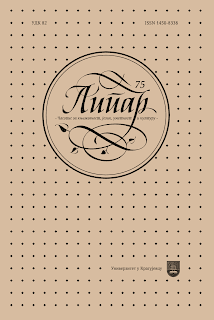СИНТАКСИЧКО-СТИЛИСТИЧКЕ ОСОБЕНОСТИ ГЛАГОЛСКИХ ОБЛИКА У ПЕСМАМА „ЖЕНИДБА БЕГА ЉУБОВИЋА“ И „ЗИРКА КАЈОВИЋА“ РАДОВАНА БЕЋИРОВИЋА
SYNTACTIC-STYLISTIC FEATURES OF VERB FORMS IN THE POEMS THE MARRIAGE OF BEY LJUBOVIĆ AND ZIRKA KAJOVIĆA BY RADOVAN BEĆIROVIĆ
Author(s): Arsenije M. SretkovićSubject(s): Language studies, Language and Literature Studies, Theoretical Linguistics, Applied Linguistics, Studies of Literature, Morphology, Syntax, Serbian Literature, Eastern Slavic Languages, Philology, Stylistics
Published by: Универзитет у Крагујевцу
Keywords: Radovan Bećirović;stylistics;syntax;verb forms;indicative;relative;futuroid
Summary/Abstract: This paper deals with verb forms in the poems The Marriage of Bey Ljubović and Zirka Kajovića from the stylistic and syntactic standpoint. The analysis procedure includes a syntactic indicative, a syntactic relative, qualifier, gnome form, narrative form, and absolute. In addition, referentiality and non-referentiality of verb forms are considered. Bearing in mind that verb forms are most often combined, the stylistic effects of combinations of verb forms are considered. This paper aims to determine the inventory of verb forms and describe their syntactic and stylistic features. The analysis showed that a rich inventory of verb forms could be found in Radovan Bećirović’s poems. Simple Past Tense, Truncated Perfect, imperfect, aorist, and temporally transposed Present Tense denote the past. In both poems, the future is expressed by the future one, and apart from it, in the poem The Marriage of Bey Ljubović, a futuroid is found. The present is realized in a syntactic indicative, and, additionally, it is found as a qualifying, gnomic, and narrative present, of which it is most often used as a narrative. Examples of presentations with modal meanings are not uncommon. In terms of referentiality, present forms in poems denote referential and non-referential actions. The infinitive is found as a complement to modal or phase verbs and is also used in the absolute. The past is realized in the syntactic indicative and the syntactic relative and denotes referential and non-referential actions. The aorist is a high-frequency verb form in the poem The Marriage of Bey Ljubović and is used in most cases as a narrative. The imperfect is realized in syntactic relative and suggests referential and non-referential actions. The Future Simple Tense is found in the syntactic relative, then the absolute, and with modal meanings, i.e., the meaning of intention, commandments, possibilities, etc. While the use of the Future Simple is linked to the heroes’ discourses, the futuroid appears in the narrative discourse. Except in the function of Future Simple, futuroid is found in gnome use. The pre- sent, the aorist, the imperfect, and the truncated perfect are forms whose stylistic features contribute to the topicality, experience, dynamism, and drama of the events being reported.
Journal: Липар - часопис за књижевност, језик, уметност и културу
- Issue Year: XXII/2021
- Issue No: 75
- Page Range: 211-227
- Page Count: 17
- Language: Serbian

